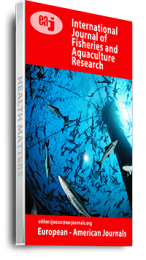Noble gourami, Ctenops nobilis McClelland, 1845 is one of the most valuable freshwater indigenous ornamental fish currently depends only on natural collection for its trade. In order to decline the population of fish, suppliers cannot meet the market demand so breeding and large scale seed production of C. nobilis is an urgent need. The knowledge of food and feeding habit of fish has been profitably utilised in culture operation. The gut content analysis showed the maximum amount of zooplankton with 31% and tiny crustacean with 27%. The length of alimentary canal and the RLG value (1.06-2.18) implies that the fish is carnivorous in nature. Seasonal changes in RLG and monthly changes in GaSI value recorded for the fish. The values of GaSI have been observed to become high during March to May with the peak being in March. Tubifex and Daphnia gave the higher rate growth with 1.63 FCR.
Keywords: Growth, Nobel gourami, alimentary canal, feeding habit

